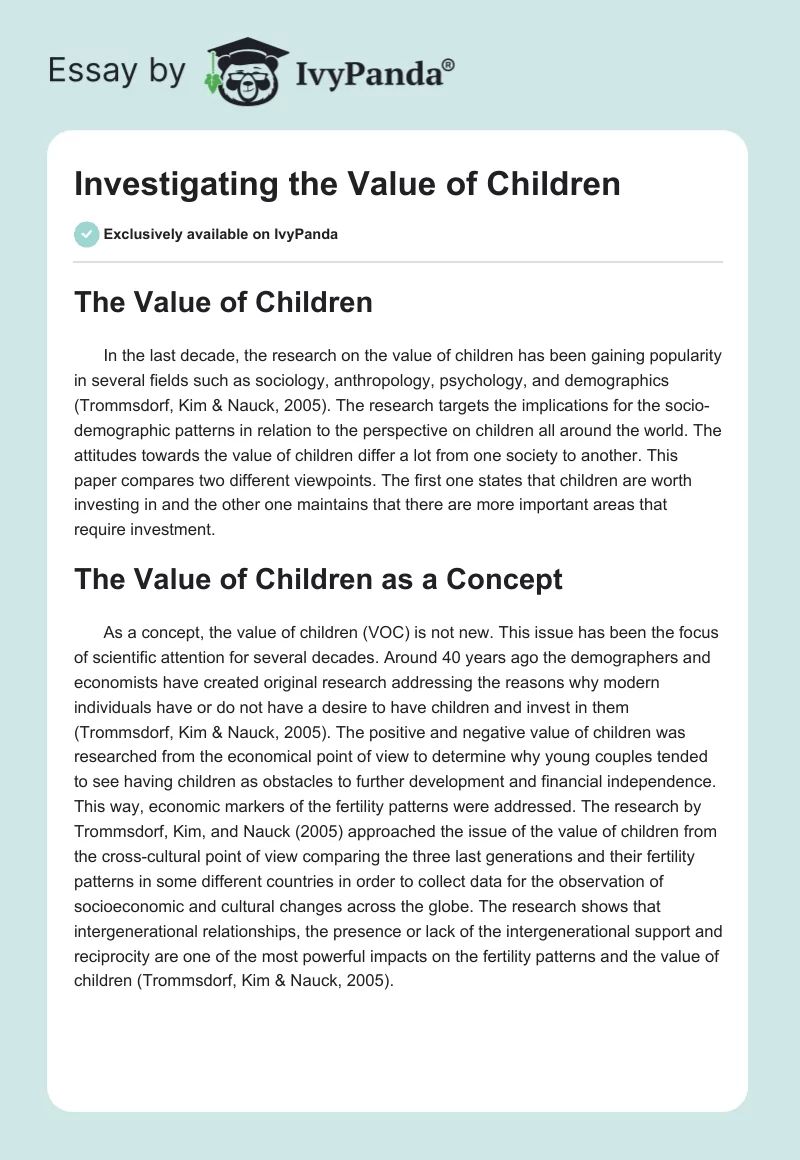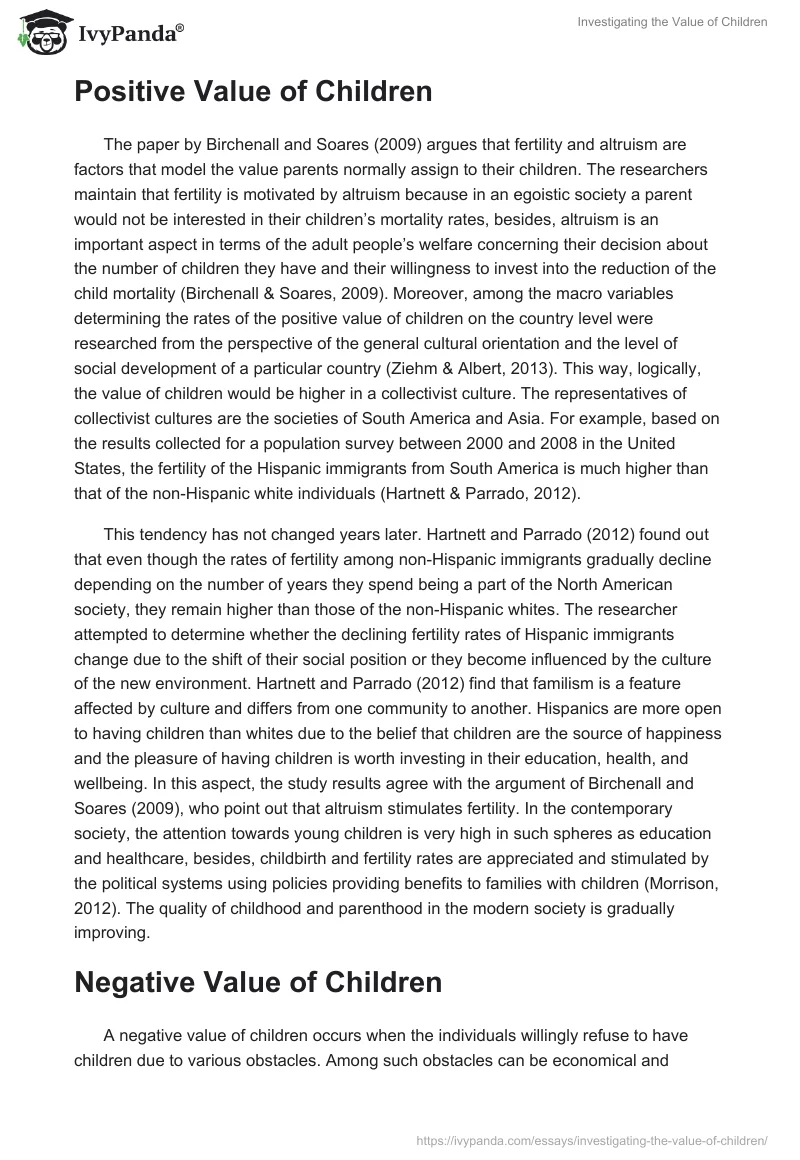The Value of Children
In the last decade, the research on the value of children has been gaining popularity in several fields such as sociology, anthropology, psychology, and demographics (Trommsdorf, Kim & Nauck, 2005). The research targets the implications for the socio-demographic patterns in relation to the perspective on children all around the world. The attitudes towards the value of children differ a lot from one society to another. This paper compares two different viewpoints. The first one states that children are worth investing in and the other one maintains that there are more important areas that require investment.
The Value of Children as a Concept
As a concept, the value of children (VOC) is not new. This issue has been the focus of scientific attention for several decades. Around 40 years ago the demographers and economists have created original research addressing the reasons why modern individuals have or do not have a desire to have children and invest in them (Trommsdorf, Kim & Nauck, 2005). The positive and negative value of children was researched from the economical point of view to determine why young couples tended to see having children as obstacles to further development and financial independence. This way, economic markers of the fertility patterns were addressed. The research by Trommsdorf, Kim, and Nauck (2005) approached the issue of the value of children from the cross-cultural point of view comparing the three last generations and their fertility patterns in some different countries in order to collect data for the observation of socioeconomic and cultural changes across the globe. The research shows that intergenerational relationships, the presence or lack of the intergenerational support and reciprocity are one of the most powerful impacts on the fertility patterns and the value of children (Trommsdorf, Kim & Nauck, 2005).
Positive Value of Children
The paper by Birchenall and Soares (2009) argues that fertility and altruism are factors that model the value parents normally assign to their children. The researchers maintain that fertility is motivated by altruism because in an egoistic society a parent would not be interested in their children’s mortality rates, besides, altruism is an important aspect in terms of the adult people’s welfare concerning their decision about the number of children they have and their willingness to invest into the reduction of the child mortality (Birchenall & Soares, 2009). Moreover, among the macro variables determining the rates of the positive value of children on the country level were researched from the perspective of the general cultural orientation and the level of social development of a particular country (Ziehm & Albert, 2013). This way, logically, the value of children would be higher in a collectivist culture. The representatives of collectivist cultures are the societies of South America and Asia. For example, based on the results collected for a population survey between 2000 and 2008 in the United States, the fertility of the Hispanic immigrants from South America is much higher than that of the non-Hispanic white individuals (Hartnett & Parrado, 2012).
This tendency has not changed years later. Hartnett and Parrado (2012) found out that even though the rates of fertility among non-Hispanic immigrants gradually decline depending on the number of years they spend being a part of the North American society, they remain higher than those of the non-Hispanic whites. The researcher attempted to determine whether the declining fertility rates of Hispanic immigrants change due to the shift of their social position or they become influenced by the culture of the new environment. Hartnett and Parrado (2012) find that familism is a feature affected by culture and differs from one community to another. Hispanics are more open to having children than whites due to the belief that children are the source of happiness and the pleasure of having children is worth investing in their education, health, and wellbeing. In this aspect, the study results agree with the argument of Birchenall and Soares (2009), who point out that altruism stimulates fertility. In the contemporary society, the attention towards young children is very high in such spheres as education and healthcare, besides, childbirth and fertility rates are appreciated and stimulated by the political systems using policies providing benefits to families with children (Morrison, 2012). The quality of childhood and parenthood in the modern society is gradually improving.
Negative Value of Children
A negative value of children occurs when the individuals willingly refuse to have children due to various obstacles. Among such obstacles can be economical and political situation, cultural orientation, and social status. For example, the rates of fertility may decline in the countries trapped in the middle of armed conflicts. Logically, having children in unstable and dangerous environments would not be favorable. Another demonstration of political influences on the rates of fertility can be seen in the patterns of son preference in the societies of the South and North India. In the South of India the son preference is lower due to such factors are the higher cost of education and in the North, the higher son preference is dictated by the prevailing agriculture (Ziehm & Albert, 2013). Of course, this tendency in India is influenced by cultural and economic determinants as well: higher religiosity promotes son preference and higher economic positions demote it. Ziehm and Albert (2013) also explain the lower fertility rates in the countries of Western Europe, among the factors impacting attitudes towards the value of children there are concerns about employment, financial situation, accommodation issues, and costs for education for the children.
Another very strong factor that determines the negative value of children is the negative personal experience caused by the living conditions and financial problems in the families. In other words, people who grew up in low-income families and witnessed their parents’ struggles with finances in childhood are more likely to be reluctant about having the children of their own when they have doubts about their future financial stability and independence. A negative value of children means that the potential parents do not desire to have children because they have alternative sources of value (Nauck, 2014). Such alternative sources of value can be of individual or institutional character, among them there are social security, the value of personal time, the cost of opportunities, and of course, financial costs. These factors work as barriers that prevent the potential parents from attaching value to children and make them choose different values. Besides, individualistic Western societies generally promote the negative value of children positioning them as obstacles for individual happiness.
Comparison and Contrast
Both positive and negative values of children are equally present in different parts of our world. The contemporary scholars have been focused on the research of the main factors that determine and predict the value of children for over four decades now. They identified cultural and social, political and economical determinants. It is often assumed that the financial situation is the main determinant of the value of children. In other words, people with higher incomes are more likely to be open to having children. At the same time, more developed Western societies are the ones going through the demographic downfall, whereas the developing countries such as India, Brazil, and China are known for the extremely high population density. A negative value of children signifies that society has alternative sources of values and does not believe that having children is worth investing in. The vision of having children as an investment predetermines the capitalist attitude towards the issue. Looking at the capitalist individualistic societies with the dominant material values makes it clear why altruism is less developed there as a phenomenon.
Conclusion
To sum up, it is difficult to promote the positive value of children in the Western societies driven by materialistic and individualistic values as the basis for investing into children for them is the payback and interest, which in this area returns only in the form of love, unity, togetherness and immaterial support. It seems that to raise the value of children the promotion of collectivism is required. Otherwise, the individuals focused on personal development, independence, hedonism, and material values would continue to prefer the sources of value alternative to family, childbirth, and fertility. The Western attitude towards children as an investment initially positions them as the sources of some kind of use.
Reference List
Birchenall, J. A. & Soares, R. R. (2009). Altruism, fertility, and the value of children: Health policy evaluation and intergenerational welfare. Journal of Public Economics, 93(1-2), 280-295.
Hartnett, C. S. & Parrado, E. A. (2012). Hispanic familism reconsidered:
Ethnic differences in the perceived value of children and fertility intentions. The Sociological Quarterly, 53(4), 636–653.
Morrison, G. S. (2012). Early Childhood Education Today (12th ed.). Upper Saddle River, NJ: Pearson Education.
Nauck, B. (2014). Value of Children and the social production of welfare. Demographic Research, 30(66), 1793–1824.
Trommsdorf, G., Kim, U., & Nauck, B. (2005). Factors influencing value of children and intergenerational relations in times of social change: Analyses from psychological and socio-cultural perspectives: Introduction to the Special Issue. Applied Psychology: An International Review, 54(3), 313 –316
Ziehm, J. & Albert, I. (2013). New developments and recent research questions in the project “Value of Children and Intergenerational Relations”. Diskurs Kindheits- und Jugendforschung, 8(1), p113-118.


